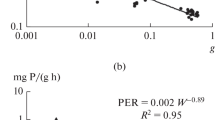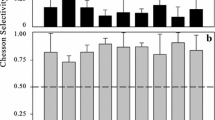Abstract
Measurements were made of the rates of grazing of the ostracod Cyprinotus carolinensis fed 14C-labelled filamentous blue-green algae (cyanobacteria). The grazing rate was a linear function of food concentration at densities below 1.1 µg dry weight of algae · ml-1 and independent of concentration at densities above 11.5 µg algae · ml-1. Starvation affected grazing rates significantly, but light vs. dark feeding, animal density, and the volume of feeding container did not. Grazing on Nostoc sp. was a linear function of ostracod size. Respiration of C. carolinensis and the blue-green algae was not a significant factor in the tests of grazing.
Similar content being viewed by others
References
Anraku, M., 1963. Feeding habits of planktonic copepods (Review). Nihon purankuton gakkai Ho 9: 10–35 (in Japanese).
Barnes, R. D., 1974. Invertebrate Zoology. Saunders, Philad. 970 pp.
Berner, A., 1962. Feeding and respiration in the copepod Temora longicornis (Muller). J. mar. biol. Ass. U.K. 42: 625–640.
Bowen, M., 1976. Effects of a thermal effluent on the ostracods of Par Pond, South Carolina. In: G. W. Esch & R. W. McFarlane (eds.). Thermal Ecology 2. National Technical Information Service, Springfield, Va., U.S.A., 40: 219–226.
Buikema, A. L. Jr., 1973. Filtering rate of the cladoceran, Daphnia pulex as a function of body size, light and acclimation. Hydrobiologia 41: 515–527.
Burns, C. W., 1969. Relation between filtering rate, temperature, and body size in four species of Daphnia. Limnol. Oceanogr. 14: 693–700.
Cannon, H. G., 1925. On the feeding mechanisms of a fresh water ostracod Pionocypris vidua (O. F. Muller) J. linn. Soc. Lond., Zool. 36: 325–335.
Cushing, D. H., 1958. The effect of grazing in reducing the primary production: a review. Rapp. P.-v. Reun. Cons. perm. int. Explor. Mer 144: 5–16.
De, P. K., 1939. The role of blue-green algae in nitrogen fixation in rice fields. Proc. r. Soc. B 127: 121–139.
Evans, M. S. & Stewart, J. A., 1977. Epibenthic and benthic microcrustaceans (copepods, cladocerans, ostracods) from a nearshore area in southeastern Lake Michigan. Limnol. Oceanogr. 22: 1059–1066.
Fernando, C. H., 1977. Investigations on the aquatic fauna of tropical ricefields with special reference to South East Asia. Geo-Eco-Trop 3: 169–188.
Fox, H. M., 1965. Ostracod crustacea from rice fields in Italy. Mem. Ist. ital. Idrobiol. 18: 205–214.
Fox, H. M., Milchrist, B. & Phear, E. A., 1951. Functions of haemoglobin in Daphnia. Proc. r. Soc. 138: 514–428.
Fryer, G., 1968. Evolution and adaptive radiation in the Chydoridae (Crustacea:Cladocera): A study in comparative functional morphology and ecology. Phil. Trans. r. Soc., Lond. B 254: 221–385.
Fryer, G., 1974. Evolution and adaptive radiation in the Macrothricidae (Crustacea:Cladocera): A study in comparative functional morphology and ecology. Phil. Trans. r. Soc., Lond. B 269: 137–274.
Fuller, J. L., 1937. Feeding rate of Calanus finmarchicus in relation to environmental conditions. Biol. Bull. 72: 233–246.
Gauld, D. T., 1951. The grazing rate of planktonic copepods. J. mar. biol. Ass. U.K. 29: 695–706.
Ghetti, P. F., 1973. Dynamique des populations d' Ostracodes de douze rizières italienes. Notes d'écologie. Ann. Stat. biol. Besse-en-Chandesse 7: 273–294.
Haney, J. F., 1973. An in situ examination of the grazing activities of natural zooplankton communities. Arch. Hydrobiol. 72: 87–132.
Heckman, C. W., 1974. The seasonal succession of species in a rice paddy in Vientiane, Laos. Int. Revue ges. Hydrobiol. 59: 489–507.
Heckman, C. W., 1979. Rice Field Ecology in Northeastern Thailand. Junk, The Hague. 228 pp.
Heisey, D. & Porter, K. G., 1977. The effect of ambient oxygen concentration on filtering and respiration rates of Daphnia galeata mendotae and Daphnia magna. Limnol. Oceanogr. 22: 839–845.
Horton, P. A., Rowan, M., Webster, K. E. & Peters, R. H., 1979. Browsing and grazing by cladoceran filter feeders. Can. J. Zool. 57: 206–212.
Kikuchi, E., Furusaka, C. & Kurihara, Y., 1975. Surveys of the fauna and flora in the water and soil of paddy fields. Rep. Inst. Agric. Res. Tohoku Univ. 26: 25–35.
King, C. E. & Kornicker, L. S., 1970. Ostracoda in Texas bays and lagoons: An ecological study. Smithsonian Contr. Zool. 24. Smithsonian Inst. Press, Wash. D.C. 92 pp.
Kring, R. L. & O'Brien, W. J., 1976. Accommodation of Daphnia pulex to altered pH conditions as measured by feeding rate. Limnol. Oceanogr. 21: 313–315.
Lampert, N., 1975. A tracer study on the carbon turnover of Daphnia pulex. Verh. int. Ver. Limnol. 19: 2913–2921.
Marshall, S. M. & Orr, A. P., 1955. On the biology of Calanus finmarchicus. 8. Food uptake, assimilation and excretion in adult and stage V Calanus. J. mar. biol. Ass. U.K. 34: 495–529.
Marshall, S. M. & Orr, P. A., 1962. Food and feeding in copepods. Rapp. P.-v. Réun. Cons. perm. int. Explor. Mer 152: 92–98.
Mason, I. L., 1939. Studies on the fauna of an Algerian hot spring. J. exp. Biol. 16: 487–498.
McMahon, J. W., 1965. Some physical factors influencing the feeding behavior of Daphnia magna Straus. Can. J. Zool. 43: 603–611.
McMahon, J. W. & Rigler, F. H., 1963. Mechanisms regulating the feeding rate of Daphnia magna Straus. Can. J. Zool. 41: 321–332.
McMahon, J. W. & Rigler, F. H., 1965. Feeding rate of Daphnia magna Straus in different foods labeled with radioactive phosphorus. Limnol. Oceanogr. 10: 105–113.
Mills, D. H. & Wyatt, J. T., 1974. Ostracod reactions to nontoxic and toxic algae. Oecologia 17: 171–177.
Mullin, M. M., 1963. Some factors affecting the feeding of marine copepods of the genus Calanus. Limnol. Oceanogr. 8: 239–250.
Mullin, M. M., Stewart, E. F. & Fuglister, F. J., 1975. Ingestion by planktonic grazers as a function of concentration of food. Limnol. Oceanogr. 20: 259–262.
Nauwerck, A., 1959. Zur Bestimmung der Filtrierrate limnischer Planktontiere. Arch. Hydrobiol. Suppl. 25: 83–101.
Osa-Afiana, L. O. & Alexander, M., 1981. Factors affecting predation by a microcrustacean (Cypris sp.) on nitrogen-fixing blue-green algae. Soil Biol. Biochem. 13: 27–32.
Pierre, D., 1973. Etude écologique comparée des populations d'ostracodes dans deux étangs de pisciculture en haute Belgique. Hydrobiologia 43: 273–284.
Pont, D., 1977. Structure et evolution saisonnière des populations de Copépods, Cladocéres et Ostracodes de rizières Camargue. Ann. Limnol. 13: 15–28.
Richman, S., 1971. Calorimetry. In: W. T. Edmondson & G. G. Winberg (eds.). A Manual on Methods for the Assessment of Secondary Productivity in Fresh Waters. Blackwell Scientific Publications, Oxford: 146–149.
Rigler, F. H., 1961. The relation between concentration of food and feeding rate of Daphnia magna Straus. Can. J. Zool. 39: 857–868.
Rigler, F. H., 1971. Zooplankton. In: W. T.Edmondson & G. G.Winberg (eds.). A Manual on Methods for the Assessment of Secondary Productivity in Fresh Waters. Blackwell Scientific Publications, Oxford: 228–256.
Robertson, D., 1880. The fauna of Scotland with special reference to Clydesdale and the Western District. Fresh and brackish water Ostracoda. Trans. nat. Hist. Soc. Glasg. 4: 1–35.
Schindler, D. W., 1968. Feeding, assimilation and respiration rates of Daphnia magna under various environmental conditions and their relation to production estimates. J. anim. Ecol. 37: 369–385.
Stangenberg, M., 1968. Toxic effect of Microcystis aeruginosa Kg extracts on Daphnia longispina O. F. Muller and Eucypris virens Jurine. Hydrobiologia 32: 81–87.
Stanier, R. Y., Kunisawa, R., Mandel, M. & Cohen-Bazire, G., 1971. Purification and properties of unicellular blue-green algae (order Chroococcales). Bact. Rev. 35: 171–205.
Tressler, W. L., 1959. Ostracoda. In: W. T. Edmondson (ed.). Freshwater Biology. John Wiley & Sons, N.Y.: 657–734.
Wickstrom, C. E. & Castenholz, R. W., 1973. Thermophilic ostracod: aquatic metazoan with the highest known temperature tolerance. Science 181: 1063–4.
Wickstrom, C. E. & Castenholz, R. W., 1978. Association of Pleurocapsa and Calothrix (Cyanophyta) in a thermal stream. J. Phycol. 14: 84–88.
Williams, R., 1969. Ecology of the Ostracoda from selected marine intertidal localities on the coast of Anglesea. In: J. W. Neale (ed.). The taxonomy, morphology and ecology of recent Ostracoda. Oliver & Boyd, Edinburgh: 229–237.
Wilson, J. T., Greene, S. & Alexander, M., 1980. Effect of microcrustaceans on blue-green algae in flooded soil. Soil Biol. Biochem. 12: 237–240.
Yamaguchi, M., 1979. Biological nitrogen fixation in flooded rice field. In: Nitrogen and Rice. Int. Rice Res. Inst., Los Banos, Philipp.: 193–204.
Zinn, D. J., 1940. Presence of living ostracods in the intestial tract of Triturus v. viridescens. Ann. Mag. nat. Hist. 5: 126–128.
Author information
Authors and Affiliations
Rights and permissions
About this article
Cite this article
Grant, I.F., Egan, E.A. & Alexander, M. Measurement of rates of grazing of the ostracod Cyprinotus carolinensis on blue-green algae. Hydrobiologia 106, 199–208 (1983). https://doi.org/10.1007/BF00008117
Received:
Revised:
Accepted:
Published:
Issue Date:
DOI: https://doi.org/10.1007/BF00008117




